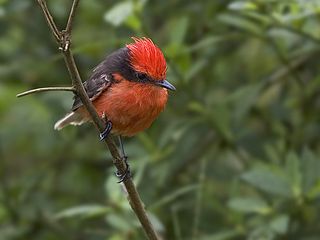Trimmatom nanus, the midget dwarfgoby, is a species of marine goby native to the Indian Ocean and the western Pacific Ocean. It can mainly be found on oceanic drop-offs at depths of from 20 to 30 metres though it can occasionally be found in outer reef areas and lagoons at depths of from 5 to 35 metres. This species can reach a length of 1 centimetre (0.39 in) SL.
The dwarf hutia is known only from Cuba. It was last seen in 1937.

Clingfishes are fishes of the family Gobiesocidae, the only family in the order Gobiesociformes. These fairly small to very small fishes are widespread in tropical and temperate regions, mostly near the coast, but a few species in deeper seas or fresh water. Most species shelter in shallow reefs or seagrass beds, clinging to rocks, algae and seagrass leaves with their sucking disc, a structure on their chest.
Corydoras nanus is a tropical freshwater fish belonging to the Corydoradinae sub-family of the family Callichthyidae. It originates in inland waters in South America, and is found in the Suriname and Maroni River basins in Suriname and the Iracoubo River basin in French Guiana.
Priocharax is a genus of characins, very small freshwater fish from the Amazon and Orinoco basins in tropical South America.
The longsnout pipefish is a pipefish of the family Syngnathidae. It has only been recorded from midwater and bottom trawls at depths of 37–212 metres (121–696 ft). The habitat and biology of this species are almost unknown but juveniles have been recorded in the stomachs of blue penguins and Snares penguins.

Plectranthias is a genus of ray-finned fish in the subfamily Anthiinae, part of the family Serranidae, the groupers and sea basses. They are found in the Atlantic, Indian and Pacific Ocean.

Phrynobatrachus nanus is a species of frog in the family Phrynobatrachidae. It is endemic to the Central African Republic and is only known from its type locality, Bouala, at 998 m (3,274 ft) above sea level on the Ouham River. Common name Buala river frog has been coined for this species.

The southern sleeper shark or Whitley's sleeper shark is a deepwater benthopelagic sleeper shark of the family Somniosidae found in the southern Atlantic, Indian, and Pacific Oceans.

True gobies were a subfamily, the Gobiinae, of the goby family Gobiidae, although the 5th edition of the Fishes of the World does not subdivide the Gobiidae into subfamilies. They are found in all oceans and a few rivers and lakes, but most live in warm waters. Altogether, the Gobiinae unite about 1149 described species in 160 genera, and new ones are still being discovered in numbers.

Darwin's flycatcher or little vermilion flycatcher is a species of flycatcher, closely related to the vermilion flycatcher. It is endemic to the Galápagos Islands. The taxon was described as full species Pyrocephalus dubius by John Gould in 1838. The same threats that led to the San Cristóbal flycatcher's extinction, including invasive species such as rats, threaten the Darwin's flycatcher today. Populations on the islands of Santa Cruz,, Fernandina, Rabida and Isabela. It lives in humid forests and shrubland. They have an average lifespan of 5 years.
Enneapterygius nanus, the pygmy triplefin or pygmy threefin, is a species of triplefin blenny in the genus Enneapterygius. It was described by Leonard Peter Schultz in 1960. This species is found from Taiwan and central Indonesia to New Caledonia and the Marshall Islands.
Penetopteryx is a genus of pipefishes.
Lipariscus nanus, the pygmy snailfish, is a species of snailfish native to the northern Pacific Ocean where it occurs in deep waters down to 910 metres (2,990 ft). The range is broad, extending from the Sea of Okhotsk north to the western Bering Sea, and from Monterey Bay, California, north to the Gulf of Alaska. This species grows to a length of 6.3 centimetres (2.5 in) SL in males and to 7.1 centimetres (2.8 in) SL in females. It is the only known member of its genus.

Lubricogobius is a genus of fish in the family Gobiidae found in the Pacific Ocean.

The whitespotted grouper, also known as the ocellated rockcod, small-spotted cod, white-spotted reef-cod or whitespotted rockcod, is a species of marine ray-finned fish, a grouper from the subfamily Epinephelinae which is part of the family Serranidae, which also includes the anthias and sea basses. It has an Indo-Pacific distribution. It is closely related to two other species of white spotted groupers in the genus Epinephelus.

Ooperipatellus nanus is a species of velvet worm in the Peripatopsidae family. This species is endemic to New Zealand and is found in the South Island.
Microdevario nana is a species of cyprinid found endemic to Myanmar. It belongs to the genus Microdevario, which contains small danionins. It reaches up to 1.9 cm (0.75 in) in length.

The pygmy shore eel is a species of clingfish from the family Gobiesocidae. It is endemic to south eastern Australia where it can be found within seagrass beds and sometimes on rocky reefs at depths of less than 10 metres (33 ft) from Point Cartwright in Queensland to Flinders Island, South Australia; its range includes Tasmania. This species was described as Cheilobranchus parvulus by Allan Riverstone McCulloch in 1909 from a type locality of rockpools near Sydney.










